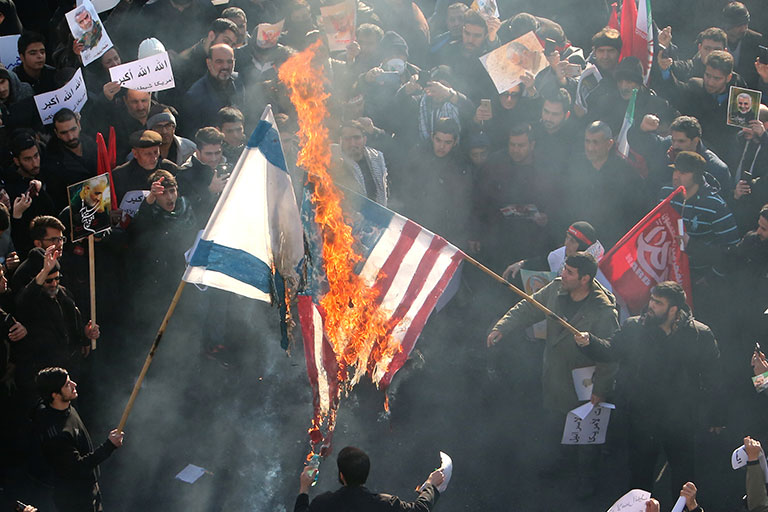
This article is taken from our FREE daily investment email Money Morning.
Every day, MoneyWeek’s executive editor John Stepek and guest contributors explain how current economic and political developments are affecting the markets and your wealth, and give you pointers on how you can profit.
Happy New Year!
It’s always good to start a new decade on an optimistic note.
So coming back to headlines fretting about World War III is perhaps not the best way to start the year.
The latest on the Cold War in the Middle East
At the end of last year, I said that I reckoned that oil would be one theme to watch in 2020. But I’ll admit I didn’t expect it to be grabbing headlines quite as early on in proceedings.
Long story short – as you’re probably already aware of what’s going on – on Friday, Iranian general Qasem Soleimani was killed in an airstrike at Baghdad airport. The airstrike was ordered by the US.
Soleimani was the head of the Iranian Revolutionary Guards’ Quds Force. It’s considered a terrorist organisation by the US, and the US says that Soleimani was “actively developing plans to attack American diplomats and service members in Iraq and throughout the region”. The airstrike also followed an attack on the US embassy in Iraq.
Now, let me make one thing clear before we go any further: I’m not an expert on Middle Eastern politics and, unlike lots of people on Twitter, I feel no need to pretend to be. I hadn’t heard of this guy until this happened.
My broad understanding of the Middle East is that Saudi Arabia and Iran are at loggerheads, and they are effectively engaged in proxy wars across the region. Yemen and Syria are two examples.
Overlaid on that, you have the US, whose interests are broadly aligned with those of the Saudis (although increasingly less so, because the US is now energy independent), and the Russians, whose interests and sphere of influence broadly aligns them with Iran.
Whatever you think of what’s going on here, or who did what and where, and who the “goodies” are and who the “baddies” are, one thing is reasonably clear to a non-expert eye: things are hotting up in the Middle East, which is still a hugely important area for global oil production.
In turn, that suggests that the relative complacency that hung over the oil market last year is likely to disappear this year. Particularly if the demand side holds up better than many investors fear.
So what happens now?
This does not mean war – not outright, in any case
Tom Holland (no, not that one – and no, not that one either) of Gavekal argues that, for all the headlines, this doesn’t represent the sort of escalation that the papers are fearing.
On the one hand, the US feels that diplomacy has failed to contain Iran. The nuclear deal collapsed ages ago. Meanwhile, sanctions aren’t squeezing the regime to change its mind. Nor are they fomenting the kind of anger required for internal regime change to take place.
On the other hand, the US does not want to get involved in any more open wars in the Middle East. At least one factor behind Donald Trump’s election was a desire on the part of the US populous to put Iraq – and foreign wars in general – behind them.
A core part of “America First” as an ideology, is an end to “Pax Americana”. Let the rest of the world sort out its problems – America’s got enough to be getting on with at home. I wouldn’t underestimate how important that is to Trump’s core voters.
So, argues Holland, getting rid of Soleimani was the best of a bunch of bad options as far as the US goes. And on the Iranian side – it’s one thing to threaten retaliation, or to consider shutting down the Strait of Hormuz, but it’s quite another to go through with it. For all that the US is reluctant to go to war, there’s no question who would “win” if it came to all-out warfare.
As Holland puts it, “the very reason Tehran has sought to extend its regional influence through the asymmetric methods championed by Soleimani is precisely because it cannot take on the US directly”.
In turn, he argues, this means that “the risk premium being priced in by financial markets is likely to remain limited – with oil remaining in its 14-month range capped at $75 per barrel for Brent – and to abate over time, at least until the next flare-up”.
Markets are still too complacent on oil
I suspect that Holland’s analysis is probably accurate in terms of the risk of a big conflagration. However, I’m not so sure about the argument on the risk premium – or at least, the idea that oil prices will be capped.
The last big surprise was the drone attack on Saudi Arabia’s production. The oil price spiked, then almost immediately came back down. We may well see a similar pattern here, but we can almost certainly expect more incidents.
And in any case, there are quite a few other factors that could mean there is less oil than required hitting global markets this year. Shale oil production growth appears to be slowing. That’s partly because the producers are struggling to fund themselves. And that’s before we get to any surprises on the demand side.
In short, I’d maintain exposure to the oil production sector. There’s still too much complacency out there. We discussed just how much complacency in our New Year roundtable in MoneyWeek magazine – if you missed it, subscribe now to get your first 12 issues for just £12.